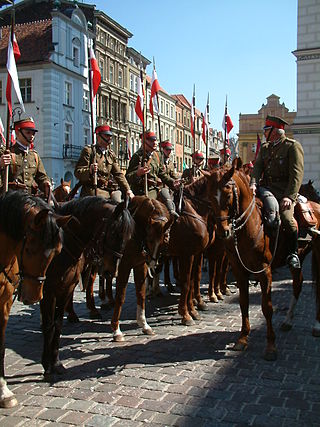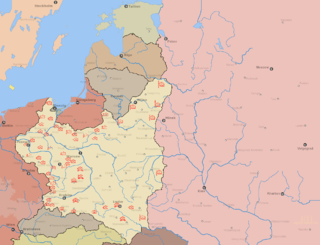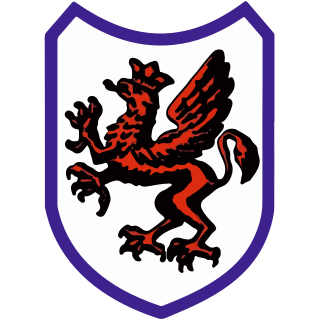
The Polish cavalry can trace its origins back to the days of medieval cavalry knights. Poland is mostly a country of flatlands and fields and mounted forces operate well in this environment. The knights and heavy cavalry gradually evolved into many different types of specialised mounted military formations, some of which heavily influenced western warfare and military science. This article details the evolution of Polish cavalry tactics, traditions and arms from the times of mounted knights and heavy winged hussars, through the times of light uhlans to mounted infantry equipped with ranged and mêlée weapons.

Operation Tempest was a series of uprisings conducted during World War II against occupying German forces by the Polish Home Army, the dominant force in the Polish resistance.

This article discusses the Polish order of battle during the invasion of Poland. In the late 1930s Polish headquarters prepared "Plan Zachód", a plan of mobilization of Polish Army in case of war with Germany. Earlier, the Poles did not regard the Germans as their main threat, priority was given to threat from the Soviets.

The siege of Warsaw in 1939 was fought between the Polish Warsaw Army garrisoned and entrenched in Warsaw and the invading German Army.

The Battle of the Bzura was both the largest battle and Polish counter-attack of the German invasion of Poland and was fought from 9 to 19 September. The battle took place west of Warsaw, near the Bzura River. It began as a Polish counter-offensive, which gained initial success, but the Germans outflanked the Polish forces with a concentrated counter-attack. That weakened Polish forces and the Poznań and Pomorze Armies were destroyed. Western Poland was now under German occupation. The battle has been described as "the bloodiest and most bitter battle of the entire Polish campaign". Winston Churchill called the battle an "ever-glorious struggle".

The 7th Infantry Division was the name of several units of the Polish Army.

The 16th Pomeranian Infantry Division is a military unit of the Polish Army. It was first raised on 16 August 1919 during the Polish uprising, before going on to serve during the subsequent war with the Bolsheviks. At the start of World War II the division fought briefly against the advancing German Army before being destroyed on 19 September 1939 after being surrounded in the Kampinos Forest. The division was raised once more in 1945 following the Soviet takeover of Poland; however, it did not see further action during the war. Afterwards it continued to serve, undergoing a number of changes in name and role. Today, it exists as the 16th Mechanised Division.
The Warsaw Army was one of the Polish armies to take part in the Polish Defensive War of 1939. Created on 8 September, eight days after the invasion begun, it was an improvised formation charged with the defence of the Polish capital of Warsaw (Warszawa).
The Polish 4th Infantry Division was created following Polish independence after the end of World War I. The division participated in the Polish–Ukrainian War in 1919. During World War II, the division existed as three wholly separate organizations, the original incarnation of the division as part of the pre-war Polish Army, the second incarnation armed and equipped by the western Allies, and another division armed and equipped and controlled by the Soviet Union. The second and third incarnations of this division existed simultaneously from 1944 until 1947.
Polish 6th Infantry Division was a unit of the Polish Army in the interbellum period, which fought in the Polish–Ukrainian War, Polish–Soviet War and Polish September Campaign. It was formed on May 9, 1919, in the area around Kraków, its first commandant was Colonel Ignacy Pick. Between 1919 and 1920, the unit fought Ukrainian troops in eastern part of former Galicia. Then, it participated in the Polish–Soviet War, halting the advance of the Soviet 1st Cavalry Army led by General Semyon Budyonny. Several soldiers were after the conflict awarded with various orders, including the Virtuti Militari. In 1921, when hostilities ended, the division returned to its bases – headquarters and most regiments were stationed in Kraków, some other regiments were garrisoned in Tarnów and Wadowice.

15th "Greater Poland" Infantry Division was a unit of the Polish Army in the interbellum period. Founded on February 17, 1920, and based on the 2nd Greater Poland Rifles Division, it actively participated in the Polish-Soviet War, including the Kiev offensive (1920), and the Battle of Warsaw. After Polish victory, the Division pushed the Red Army out of northern Mazovia. It then fought in the Battle of the Niemen River.

The Polish 26th Infantry Division was a unit of the Polish Army. Originally formed as the 4th Infantry Division (Poland) in southern Poland in April 1919, the division was renamed the 26th Infantry Division in 1921. The division would see combat in World War II, being destroyed during the German invasion of Poland in September 1939.

Pomeranian Cavalry Brigade was a cavalry unit of the Polish Army in the interbellum period. It was created on April 1, 1937 out of the Cavalry Brigade "Bydgoszcz". Its headquarters were stationed in Bydgoszcz and the brigade consisted of these units:

Greater Poland Cavalry Brigade was a cavalry unit of the Polish Army in the interbellum period. It was created on April 1, 1937 out of the Cavalry Brigade "Poznań". Its headquarters were stationed in Poznań and the brigade consisted of these units:

Podolska Cavalry Brigade was a cavalry unit of the Polish Army in the interbellum period. It was created on April 1, 1937 out of the 6th Independent Cavalry Brigade. It took its name from Podolia region. Its headquarters were stationed in Stanisławów and the brigade consisted of these units:

The 12th Bolesław KrzywoustySzczecin Mechanised Division is a division of the Polish Armed Forces, headquartered in Szczecin.
5th Lwów Infantry Division was a unit of the Polish Army in the interbellum period, with headquarters stationed in Lwów. It was created on May 20, 1919, during the Polish–Ukrainian War in Eastern Galicia. Originally, it consisted of three infantry regiments, but later it was strengthened with additional two. During Polish September Campaign it was commanded by General Juliusz Zulauf. The Division consisted in September 1939 of these regiments:

15th Poznań Uhlan Regiment – unit of Polish cavalry, part of Greater Polands Army, Polish Army of Second Republic and Polish Armed Forces in the West during World War II.

17th Greater Poland Uhlan Regiment of King Bolesław Chrobry was a cavalry unit of the Polish Army in the Second Polish Republic. Formed in late 1918, it was garrisoned in Leszno. The regiment, whose patron was King Bolesław Chrobry, fought in the Polish–Soviet War and the 1939 Invasion of Poland, as part of Wielkopolska Cavalry Brigade.
14th Infantry Regiment of the Land of Kujawy was an infantry regiment of the Polish Army. It existed from 1918 until 1939. Garrisoned in Włocławek, the unit belonged to the 4th Infantry Division from Toruń.














